Heat and Flow Characteristics of Aerofoil-Shaped Fins on a Curved Target Surface in a Confined Channel for an Impinging Jet Array
Abstract
1. Introduction
2. Modelling Outline
3. Geometry and Boundary Conditions
3.1. Mesh Independence Analysis
3.2. Validation of the Applied Computational Formulation
4. Result and Discussion
4.1. Area-Averaged Nusselt Numbers
4.2. Local Heat Transfer
4.3. Flow Features
4.4. Pressure Drop and Thermal Performance Criterion
5. Conclusions
- Mounting aerofoil fins on the surface increased overall heat transfer through the interaction between the hot surface and processing fluid. For example, an approximately 18.38% increase in heat transfer was observed only by adding fins to the target surface compared to the smooth surface at S/d = 2.0 with the L2 configuration. By decreasing S/d to 0.5 in the finned model, the best increase in overall heat transfer relative to the conventional jet impingement model was 52.81%, obtained for the L2 design.
- Interaction between adjacent jet streams produces new stagnation or slower flow zones on smooth surfaces, reducing the heat transfer rate. However, the fins led to homogeneous heat transfer distribution on the surface by minimizing stagnation points between adjacent jets. Consequently, using aerofoil fins contributed to a more uniform heat transfer across the target surface.
- Both elongated nozzle holes and aerofoil fins enhance heat transfer on the target surface. Fins provide a more homogeneous local heat transfer along the flow direction by preventing non-uniform heat transfer distribution between jet regions. On the other hand, elongated jets enhance heat transfer in the stagnation region rather than heat transfer uniformity.
- The two-row fin layout (L2) produces relatively better results in terms of both improving the mean Nu numbers and TPC values compared to the one-row (L1) and three-row fin arrangement (L3). According to the TPC values, the combination of extended nozzles and mounting fins is feasible for balancing heat transfer enhancement and pressure drop increase when the S/d ≤ 2.0 for all tested fin layouts except L1.
Author Contributions
Funding
Data Availability Statement
Conflicts of Interest
References
- Jung, E.Y.; Park, C.U.; Lee, D.H.; Kim, K.M.; Cho, H.H. Effect of the Injection Angle on Local Heat Transfer in a Showerhead Cooling with Array Impingement Jets. Int. J. Therm. Sci. 2018, 124, 344–355. [Google Scholar] [CrossRef]
- Herrero Martin, R.; Buchlin, J.M. Jet Impingement Heat Transfer from Lobed Nozzles. Int. J. Therm. Sci. 2011, 50, 1199–1206. [Google Scholar] [CrossRef]
- Hwang, S.D.; Lee, C.H.; Cho, H.H. Heat Transfer and Flow Structures in Axisymmetric Impinging Jet Controlled by Vortex Pairing. Int. J. Heat Fluid Flow 2001, 22, 293–300. [Google Scholar] [CrossRef]
- Laroche, E.; Donjat, D.; Reulet, P. A Combined Experimental and Numerical Characterization of the Flowfield and Heat Transfer around a Multiperforated Plate with Compound Angle Injection. Energies 2021, 14, 613. [Google Scholar] [CrossRef]
- Yong, S.; Zhang, J.Z.; Xie, G.N. Convective Heat Transfer for Multiple Rows of Impinging Air Jets with Small Jet-to-Jet Spacing in a Semi-Confined Channel. Int. J. Heat Mass Transf. 2015, 86, 832–842. [Google Scholar] [CrossRef]
- Fenot, M.; Vullierme, J.-J.; Dorignac, E. Local Heat Transfer Due to Several Configurations of Circular Air Jets Impinging on a Flat Plate with and without Semi-Confinement. Int. J. Therm. Sci. 2005, 44, 665–675. [Google Scholar] [CrossRef]
- Huber, A.M.; Viskanta, R. Effect of Jet-Jet Spacing on Convective Heat Transfer to Confined, Impinging Arrays of Axisymmetric Air Jets. Int. J. Heat Mass Transf. 1994, 37, 2859–2869. [Google Scholar] [CrossRef]
- Yan, W.M.; Mei, S.C.; Liu, H.C.; Soong, C.Y.; Yang, W.J. Measurement of Detailed Heat Transfer on a Surface under Arrays of Impinging Elliptic Jets by a Transient Liquid Crystal Technique. Int. J. Heat Mass Transf. 2004, 47, 5235–5245. [Google Scholar] [CrossRef]
- Jung, E.Y.; Park, C.U.; Lee, D.H.; Kim, K.M.; Woo, T.K.; Cho, H.H. Heat Transfer Characteristics of an Angled Array Impinging Jet on a Concave Duct. Proc. ASME Turbo Expo 2012, 4, 601–607. [Google Scholar] [CrossRef]
- Singh, A.; Prasad, B.V.S.S.S. Influence of Novel Equilaterally Staggered Jet Impingement over a Concave Surface at Fixed Pumping Power. Appl. Therm. Eng. 2019, 148, 609–619. [Google Scholar] [CrossRef]
- Bu, X.; Peng, L.; Lin, G.; Bai, L.; Wen, D. Experimental Study of Jet Impingement Heat Transfer on a Variable-Curvature Concave Surface in a Wing Leading Edge. Int. J. Heat Mass Transf. 2015, 90, 92–101. [Google Scholar] [CrossRef]
- Rückert, F.U.; Sauer, M.; Liimatainen, T.; Hübner, D. The Thermal Twin BT—Digital Twin Development: An Introduction to Simcenter Amesim; Rückert, F.U., Sauer, M., Liimatainen, T., Hübner, D., Eds.; Springer Nature Switzerland: Cham, Switzerland, 2023; pp. 47–57. ISBN 978-3-031-25692-9. [Google Scholar]
- Wright, I.G.; Gibbons, T.B. Recent Developments in Gas Turbine Materials and Technology and Their Implications for Syngas Firing. Int. J. Hydrogen Energy 2007, 32, 3610–3621. [Google Scholar] [CrossRef]
- Bhattacharyya, S.; Benim, A.C.; Chattopadhyay, H.; Banerjee, A. Experimental and Numerical Analysis of Forced Convection in a Twisted Tube. Therm. Sci. 2019, 23, 1043–1052. [Google Scholar] [CrossRef]
- Bhattacharyya, S.; Benim, A.C.; Pathak, M.; Chamoli, S.; Gupta, A. Thermohydraulic Characteristics of Inline and Staggered Angular Cut Baffle Inserts in the Turbulent Flow Regime. J. Therm. Anal. Calorim. 2020, 140, 1519–1536. [Google Scholar] [CrossRef]
- Chyu, M.K. Recent Advances in Turbine Heat Transfer-with a View of Transition to Coal-Gas Based Systems. J. Heat Transf. 2012, 134, 031006. [Google Scholar] [CrossRef]
- Ren, Z.; Yang, X.; Lu, X.; Li, X.; Ren, J. Experimental Investigation of Micro Cooling Units on Impingement Jet Array Flow Pressure Loss and Heat Transfer Characteristics. Energies 2021, 14, 4757. [Google Scholar] [CrossRef]
- Allauddin, U.; Uddin, N.; Weigand, B. Heat Transfer Enhancement by Jet Impingement on a Flat Surface with Detached-Ribs under Cross-Flow Conditions. Numer. Heat Transf. Part A Appl. 2013, 63, 921–940. [Google Scholar] [CrossRef]
- Behnia, M.; Parneix, S.; Durbin, P.A. Prediction of Heat Transfer in an Axisymmetric Turbulent Jet Impinging on a Flat Plate. Int. J. Heat Mass Transf. 1998, 41, 1845–1855. [Google Scholar] [CrossRef]
- Lee, S.-J.; Lee, J.-H.; Lee, D.-H. Local Heat Transfer Measurements from an Elliptic Jet Impinging on a Flat Plate Using Liquid Crystal. Int. J. Heat Mass Transf. 1994, 37, 967–976. [Google Scholar] [CrossRef]
- Kercher, D.M.; Tabakoff, W. Heat Transfer by a Square Array of Round Air Jets Impinging Perpendicular to a Flat Surface Including the Effect of Spent Air. J. Eng. Power 1970, 92, 73–82. [Google Scholar] [CrossRef]
- Tan, L.; Zhang, J.Z.; Xu, H.S. Jet Impingement on a Rib-Roughened Wall inside Semi-Confined Channel. Int. J. Therm. Sci. 2014, 86, 210–218. [Google Scholar] [CrossRef]
- Tong, F.; Gou, W.; Zhao, Z.; Gao, W.; Li, H.; Li, L. Numerical Investigation of Impingement Heat Transfer on Smooth and Roughened Surfaces in a High-Pressure Turbine Inner Casing. Int. J. Therm. Sci. 2020, 149, 106186. [Google Scholar] [CrossRef]
- Caliskan, S. Flow and Heat Transfer Characteristics of Transverse Perforated Ribs under Impingement Jets. Int. J. Heat Mass Transf. 2013, 66, 244–260. [Google Scholar] [CrossRef]
- Katti, V.; Prabhu, S.V. Heat Transfer Enhancement on a Flat Surface with Axisymmetric Detached Ribs by Normal Impingement of Circular Air Jet. Int. J. Heat Fluid Flow 2008, 29, 1279–1294. [Google Scholar] [CrossRef]
- Xie, G.; Liu, X.; Yan, H.; Qin, J. Turbulent Flow Characteristics and Heat Transfer Enhancement in a Square Channel with Various Crescent Ribs on One Wall. Int. J. Heat Mass Transf. 2017, 115, 283–295. [Google Scholar] [CrossRef]
- Chyu, M.K. Heat Transfer and Pressure Drop for Short Pin-Fin Arrays with Pin-Endwall Fillet. Proc. ASME Turbo Expo 1989, 4, 926–932. [Google Scholar] [CrossRef]
- Singh, P.; Zhang, M.; Ahmed, S.; Ramakrishnan, K.R.; Ekkad, S. Effect of Micro-Roughness Shapes on Jet Impingement Heat Transfer and Fin-Effectiveness. Int. J. Heat Mass Transf. 2019, 132, 80–95. [Google Scholar] [CrossRef]
- Bai, W.; Chen, W.; Yang, L.; Chyu, M.K. Numerical Investigation on Heat Transfer and Pressure Drop of Pin-Fin Array under the Influence of Rib Turbulators Induced Vortices. Int. J. Heat Mass Transf. 2019, 129, 735–745. [Google Scholar] [CrossRef]
- Hadipour, A.; Rajabi Zargarabadi, M.; Dehghan, M. Effect of Micro-Pin Characteristics on Flow and Heat Transfer by a Circular Jet Impinging to the Flat Surface. J. Therm. Anal. Calorim. 2020, 140, 943–951. [Google Scholar] [CrossRef]
- Wan, C.; Rao, Y.; Chen, P. Numerical Predictions of Jet Impingement Heat Transfer on Square Pin-Fin Roughened Plates. Appl. Therm. Eng. 2015, 80, 301–309. [Google Scholar] [CrossRef]
- Kannan, B.T.; Sundararaj, S. Steady State Jet Impingement Heat Transfer from Axisymmetric Plates with and without Grooves. Procedia Eng. 2015, 127, 25–32. [Google Scholar] [CrossRef]
- Liu, Y.H.; Song, S.J.; Lo, Y.H. Jet Impingement Heat Transfer on Target Surfaces with Longitudinal and Transverse Grooves. Int. J. Heat Mass Transf. 2013, 58, 292–299. [Google Scholar] [CrossRef]
- Su, L.M.; Chang, S.W. Detailed Heat Transfer Measurements of Impinging Jet Arrays Issued from Grooved Surfaces. Int. J. Therm. Sci. 2002, 41, 823–841. [Google Scholar] [CrossRef]
- Nagesha, K.; Srinivasan, K.; Sundararajan, T. Enhancement of Jet Impingement Heat Transfer Using Surface Roughness Elements at Different Heat Inputs. Exp. Therm. Fluid Sci. 2020, 112, 109995. [Google Scholar] [CrossRef]
- van Hout, R.; Rinsky, V.; Sasson, N.; Hershcovich, C.; Tshuva, M.; Grobman, Y.J. Axisymmetric Jet Impingement on a Dimpled Surface: Effect of Impingement Location on Flow Field Characteristics. Int. J. Heat Fluid Flow 2018, 74, 53–64. [Google Scholar] [CrossRef]
- Sriromreun, P.; Sriromreun, P. Experimental and Numerical Studies of Heat Transfer Characteristics for Impinging Jet on Dimple Surfaces. Chem. Eng. Trans. 2018, 70, 1273–1278. [Google Scholar] [CrossRef]
- Celik, N. Effects of Dimples’ Arrangement Style of Rough Surface and Jet Geometry on Impinging Jet Heat Transfer. Heat Mass Transf. Stoffuebertragung 2020, 56, 339–354. [Google Scholar] [CrossRef]
- Vinze, R.; Khade, A.; Kuntikana, P.; Ravitej, M.; Suresh, B.; Kesavan, V.; Prabhu, S.V. Effect of Dimple Pitch and Depth on Jet Impingement Heat Transfer over Dimpled Surface Impinged by Multiple Jets. Int. J. Therm. Sci. 2019, 145, 105974. [Google Scholar] [CrossRef]
- Li, D.; Zuo, W.; Li, Q.; Zhang, G.; Zhou, K.; E, J. Effects of Pulsating Flow on the Performance of Multi-Channel Cold Plate for Thermal Management of Lithium-Ion Battery Pack. Energy 2023, 273, 127250. [Google Scholar] [CrossRef]
- Zuo, W.; Zhang, Y.; E, J.; Li, J.; Li, Q.; Zhang, G. Performance Comparison between Single S-Channel and Double S-Channel Cold Plate for Thermal Management of a Prismatic LiFePO4 Battery. Renew. Energy 2022, 192, 46–57. [Google Scholar] [CrossRef]
- Zhang, Y.; Zuo, W.; E, J.; Li, J.; Li, Q.; Sun, K.; Zhou, K.; Zhang, G. Performance Comparison between Straight Channel Cold Plate and Inclined Channel Cold Plate for Thermal Management of a Prismatic LiFePO4 Battery. Energy 2022, 248, 123637. [Google Scholar] [CrossRef]
- Zuo, W.; Zhang, Y.; E, J.; Huang, Y.; Li, Q.; Zhou, K.; Zhang, G. Effects of Multi-Factors on Performance of an Improved Multi-Channel Cold Plate for Thermal Management of a Prismatic LiFePO4 Battery. Energy 2022, 261, 125384. [Google Scholar] [CrossRef]
- Li, J.; Zuo, W.; E, J.; Zhang, Y.; Li, Q.; Sun, K.; Zhou, K.; Zhang, G. Multi-Objective Optimization of Mini U-Channel Cold Plate with SiO2 Nanofluid by RSM and NSGA-II. Energy 2022, 242, 123039. [Google Scholar] [CrossRef]
- Bhaumik, M.; Dhanawade, K.; Sur, A. Materials Today: Proceedings A Numerical Model Analysis on Perforated Aerofoil Shaped Pin Fin Arrays in Heat Dissipation Enhancement, Pressure Drop and Optimization. Mater. Today Proc. 2023, 92, 1319–1333. [Google Scholar] [CrossRef]
- Wan, C.; Rao, Y.; Zhang, X. Numerical Investigation of Impingement Heat Transfer on a Flat and Square Pin-Fin Roughened Plates. In Volume 3A: Heat Transfer; American Society of Mechanical Engineers: San Antonio, TX, USA, 2013. [Google Scholar]
- Brakmann, R.; Chen, L.; Weigand, B.; Crawford, M. Experimental and Numerical Heat Transfer Investigation of an Impinging Jet Array on a Target Plate Roughened by Cubic Micro Pin Fins. J. Turbomach. 2016, 138, 111010. [Google Scholar] [CrossRef]
- Ndao, S.; Peles, Y.; Jensen, M.K. Experimental Investigation of Flow Boiling Heat Transfer of Jet Impingement on Smooth and Micro Structured Surfaces. Int. J. Heat Mass Transf. 2012, 55, 5093–5101. [Google Scholar] [CrossRef]
- Jin, W.; Wu, J.; Jia, N.; Lei, J.; Ji, W.; Xie, G. Effect of Shape and Distribution of Pin-Fins on the Flow and Heat Transfer Characteristics in the Rectangular Cooling Channel. Int. J. Therm. Sci. 2021, 161, 106758. [Google Scholar] [CrossRef]
- Ravanji, A.; Zargarabadi, M.R. Effects of Pin-Fin Shape on Cooling Performance of a Circular Jet Impinging on a Flat Surface. Int. J. Therm. Sci. 2021, 161, 106684. [Google Scholar] [CrossRef]
- Yalçınkaya, O.; Durmaz, U.; Tepe, A.Ü.; Uysal, Ü.; Özel, M.B. Assessment of Convective Heat Transfer Characteristics for Elliptical-Shaped Pin-Roughened Surface for the Jet Impingement Cooling. ASME J. Heat Mass Transf. 2023, 145, 022301. [Google Scholar] [CrossRef]
- Tepe, A.Ü.; Yetişken, Y.; Uysal, Ü.; Arslan, K. Experimental and Numerical Investigation of Jet Impingement Cooling Using Extended Jet Holes. Int. J. Heat Mass Transf. 2020, 158, 119945. [Google Scholar] [CrossRef]
- Yalçınkaya, O.; Durmaz, U.; Tepe, A.Ü.; Uysal, Ü.; Özel, M.B. Effect of Slot-Shaped Pins on Heat Transfer Performance in the Extended Jet Impingement Cooling. Int. J. Therm. Sci. 2022, 179, 107698. [Google Scholar] [CrossRef]
- Ravanji, A.; Zargarabadi, M.R. Effects of Elliptical Pin-Fins on Heat Transfer Characteristics of a Single Impinging Jet on a Concave Surface. Int. J. Heat Mass Transf. 2020, 152, 119532. [Google Scholar] [CrossRef]
- Benim, A.C. Finite Element Analysis of Confined Turbulent Swirling Flows. Int. J. Numer. Methods Fluids 1990, 11, 697–717. [Google Scholar] [CrossRef]
- Xia, J.L.; Smith, B.L.; Benim, A.C.; Schmidli, J.; Yadigaroglu, G. Effect of Inlet and Outlet Boundary Conditions on Swirling Flows. Comput. Fluids 1997, 26, 811–823. [Google Scholar] [CrossRef]
- Wilcox, D.C. Reassessment of the Scale-Determining Equation for Advanced Turbulence Models. AIAA J. 1988, 26, 1299–1310. [Google Scholar] [CrossRef]
- Menter, F.R. Two-Equation Eddy-Viscosity Turbulence Models for Engineering Applications. AIAA J. 1994, 32, 1598–1605. [Google Scholar] [CrossRef]
- Penumadu, P.S.; Rao, A.G. Numerical Investigations of Heat Transfer and Pressure Drop Characteristics in Multiple Jet Impingement System. Appl. Therm. Eng. 2017, 110, 1511–1524. [Google Scholar] [CrossRef]
- Lu, Q.; Muthukumar, R.; Ge, H.; Parameswaran, S. Numerical Study of a Rotating Liquid Jet Impingement Cooling System. Int. J. Heat Mass Transf. 2020, 163, 120446. [Google Scholar] [CrossRef]
- Rhee, D.H.; Choi, J.H.; Cho, H.H. Flow and Heat (Mass) Transfer Characteristics in an Impingement/Effusion Cooling System with Crossflow. J. Turbomach. 2003, 125, 74–82. [Google Scholar] [CrossRef]
- Tepe, A.Ü.; Arslan, K.; Yetisken, Y.; Uysal, Ü. Effects of Extended Jet Holes to Heat Transfer and Flow Characteristics of the Jet Impingement Cooling. J. Heat Transf. 2019, 141, 082202. [Google Scholar] [CrossRef]
- Goldstein, R.J.; Behbahani, A.I. Impingement of a Circular Jet with and without Cross Flow. Int. J. Heat Mass Transf. 1982, 25, 1377–1382. [Google Scholar] [CrossRef]
- Kim, T.; Jung, E.Y.; Bang, M.; Lee, C.; Moon, H.K.; Cho, H.H. Heat Transfer Measurements for Array Jet Impingement with Castellated Wall. In Volume 5B: Heat Transfer—General Interest; Internal Air Systems; Internal Cooling; American Society of Mechanical Engineers: New York, NY, USA, 2021. [Google Scholar]
- Boudraa, B.; Bessaïh, R. Numerical Investigation of Jet Impingement Cooling an Isothermal Surface Using Extended Jet Holes with Various Binary Hybrid Nanofluids. Int. Commun. Heat Mass Transf. 2021, 127, 105560. [Google Scholar] [CrossRef]
- Caliskan, S.; Baskaya, S. Velocity Field and Turbulence Effects on Heat Transfer Characteristics from Surfaces with V-Shaped Ribs. Int. J. Heat Mass Transf. 2012, 55, 6260–6277. [Google Scholar] [CrossRef]
- Maradiya, C.; Vadher, J.; Agarwal, R. The Heat Transfer Enhancement Techniques and Their Thermal Performance Factor. Beni-Suef Univ. J. Basic Appl. Sci. 2018, 7, 1–21. [Google Scholar] [CrossRef]
- Chang, S.W.; Chiang, P.A.; Cai, W.L. Thermal Performance of Impinging Jet-Row onto Trapezoidal Channel with Different Effusion and Discharge Conditions. Int. J. Therm. Sci. 2021, 159, 106590. [Google Scholar] [CrossRef]
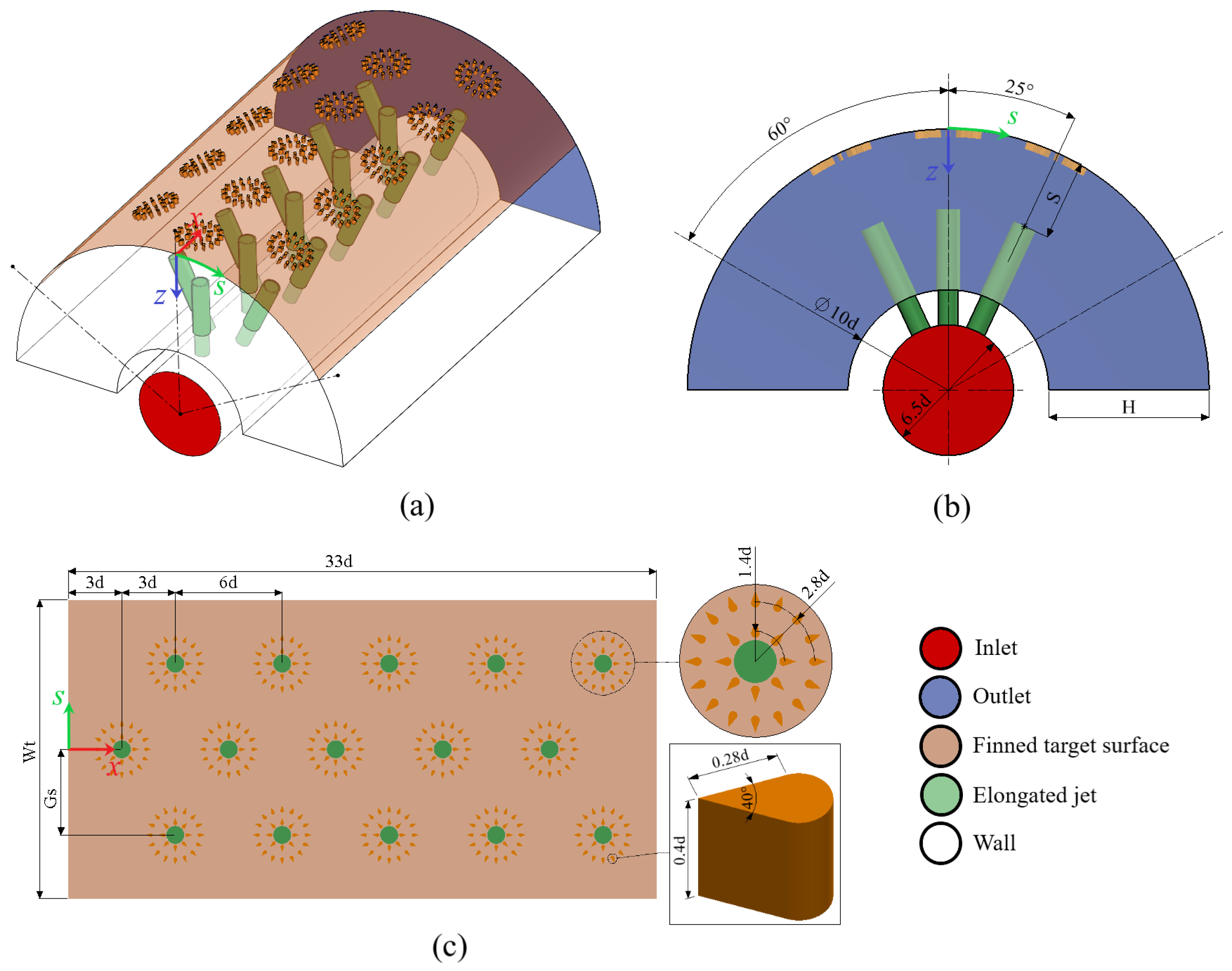
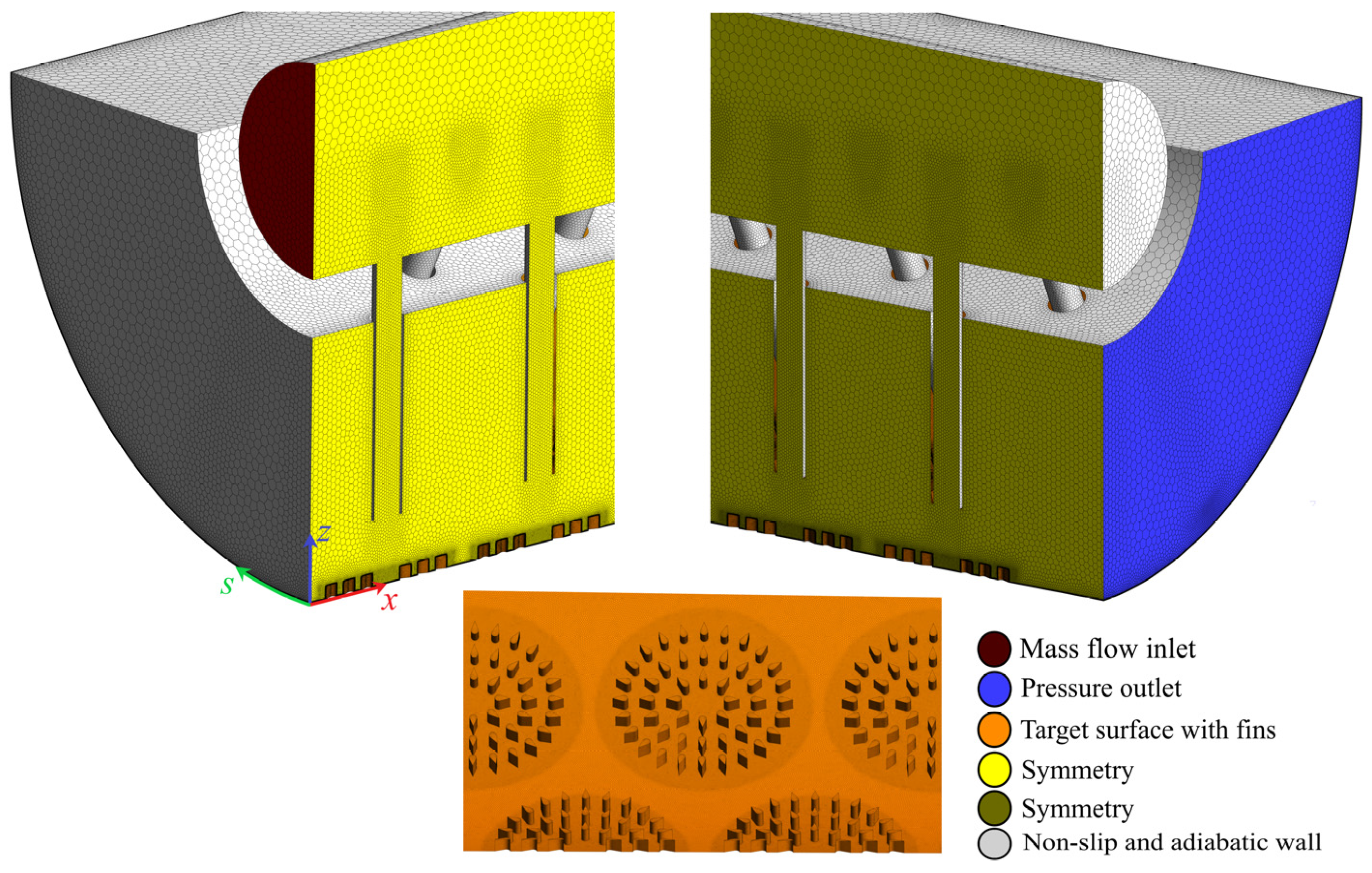
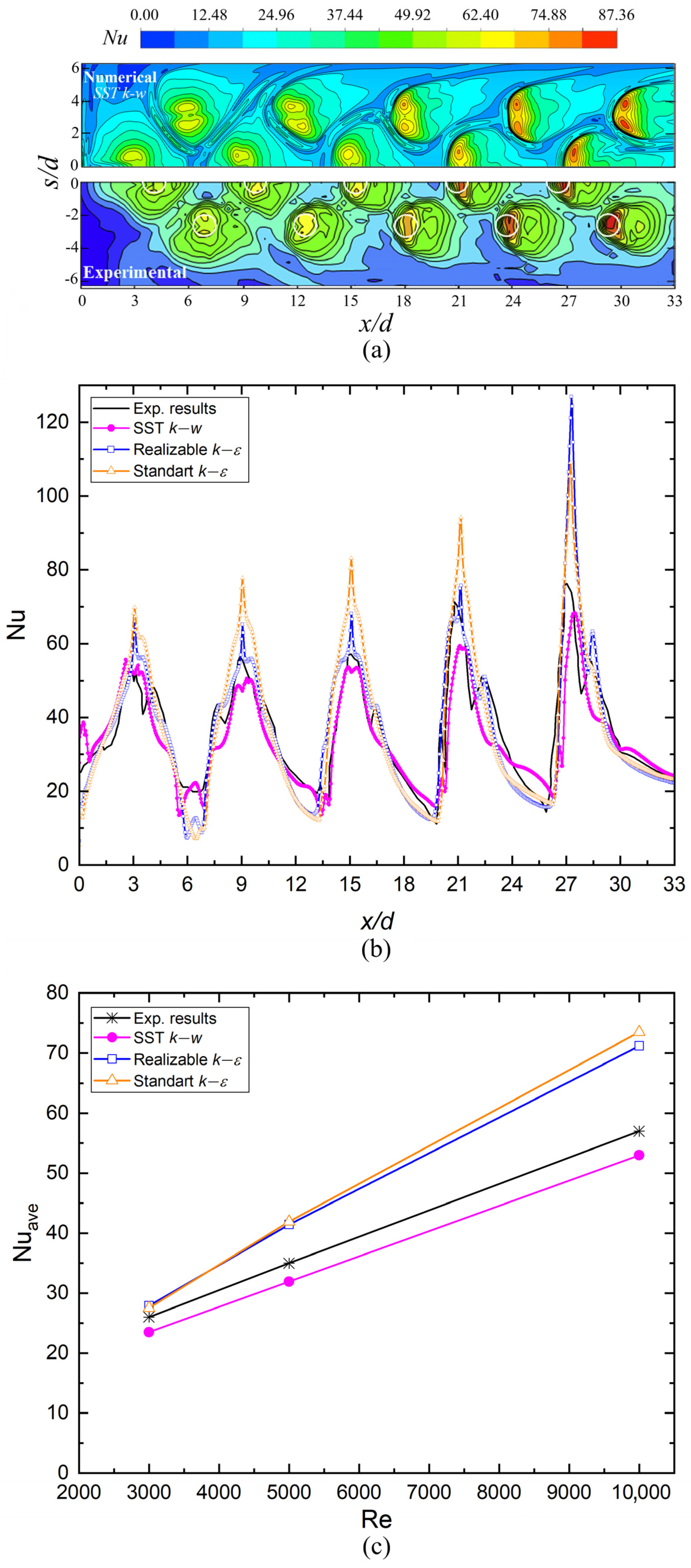
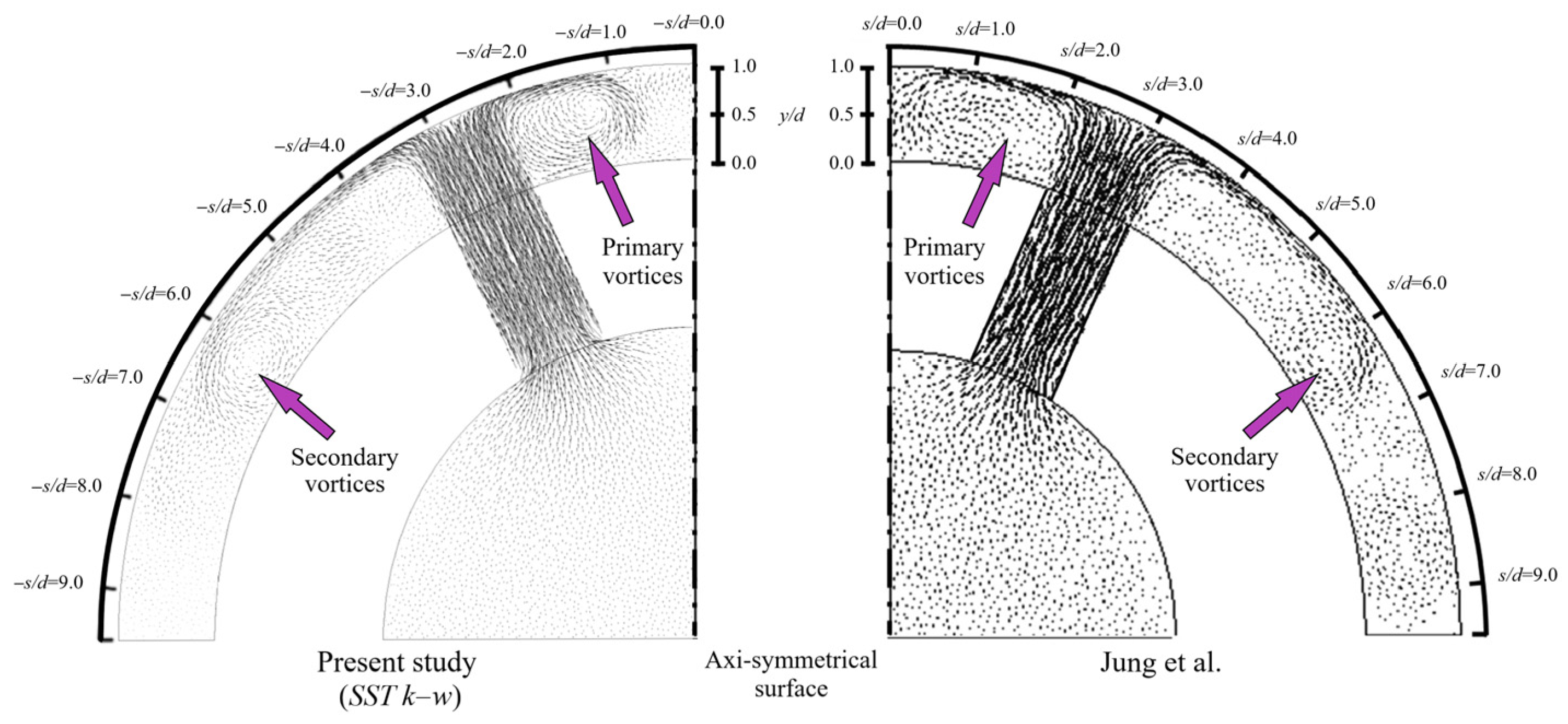


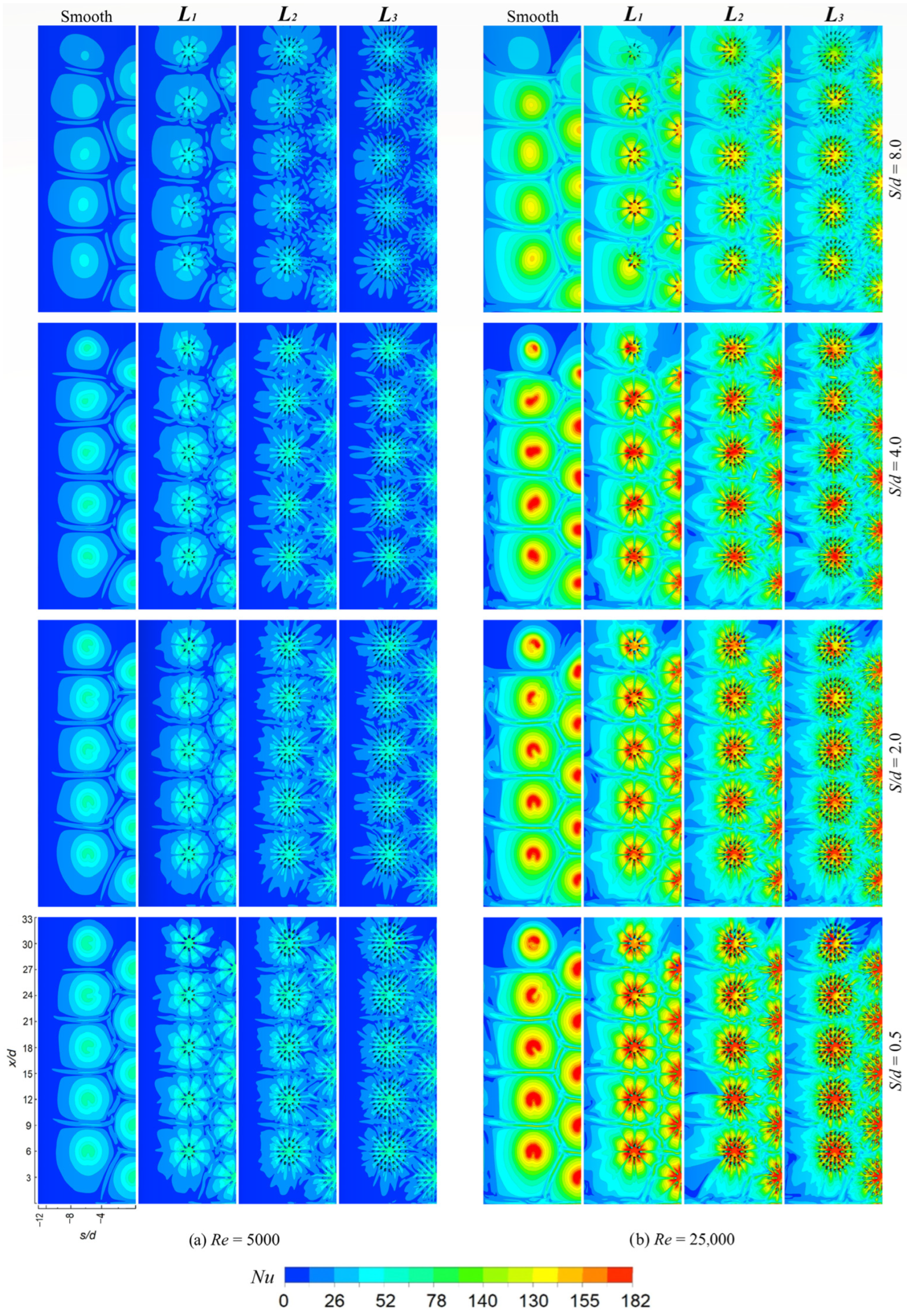
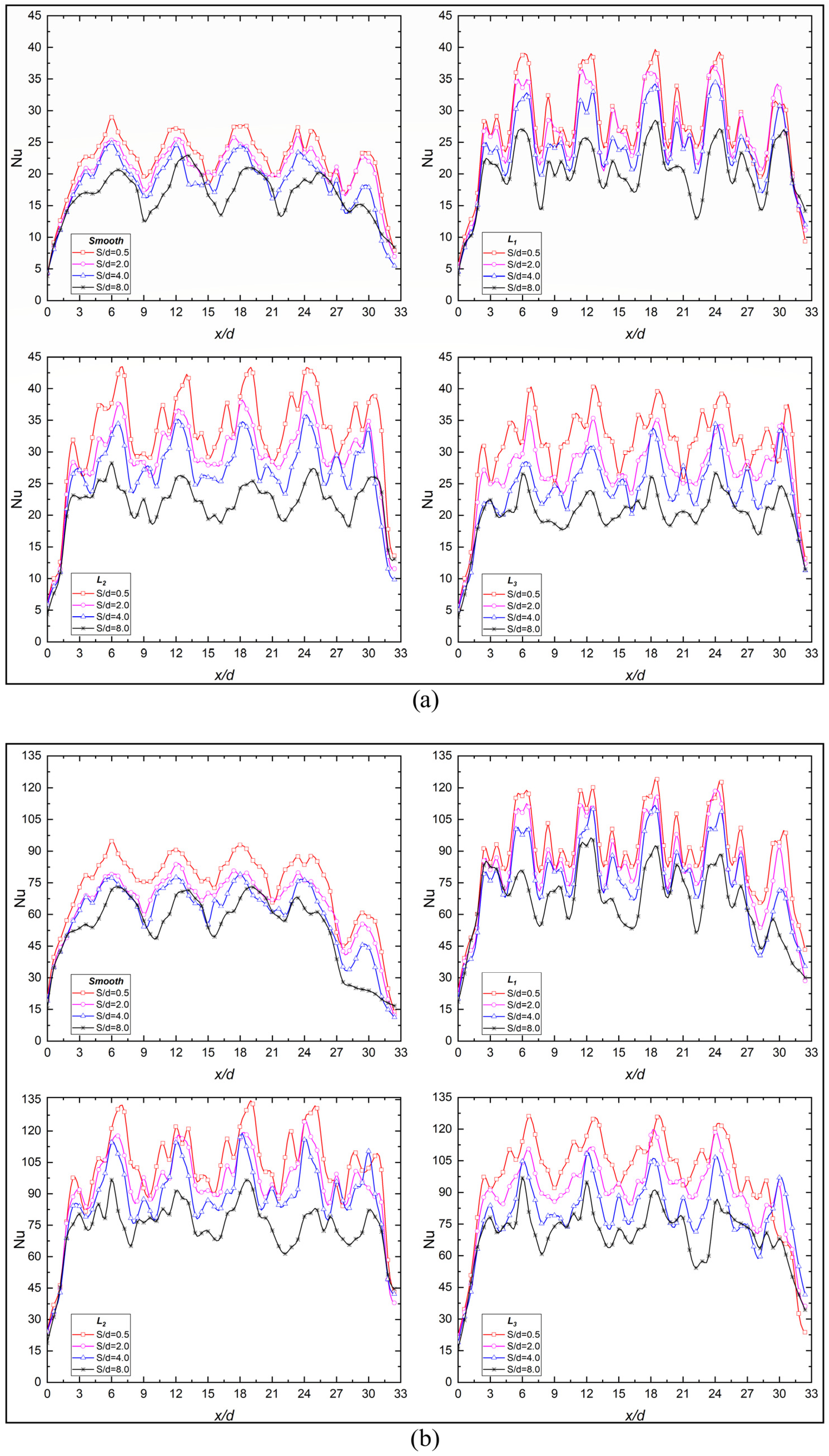
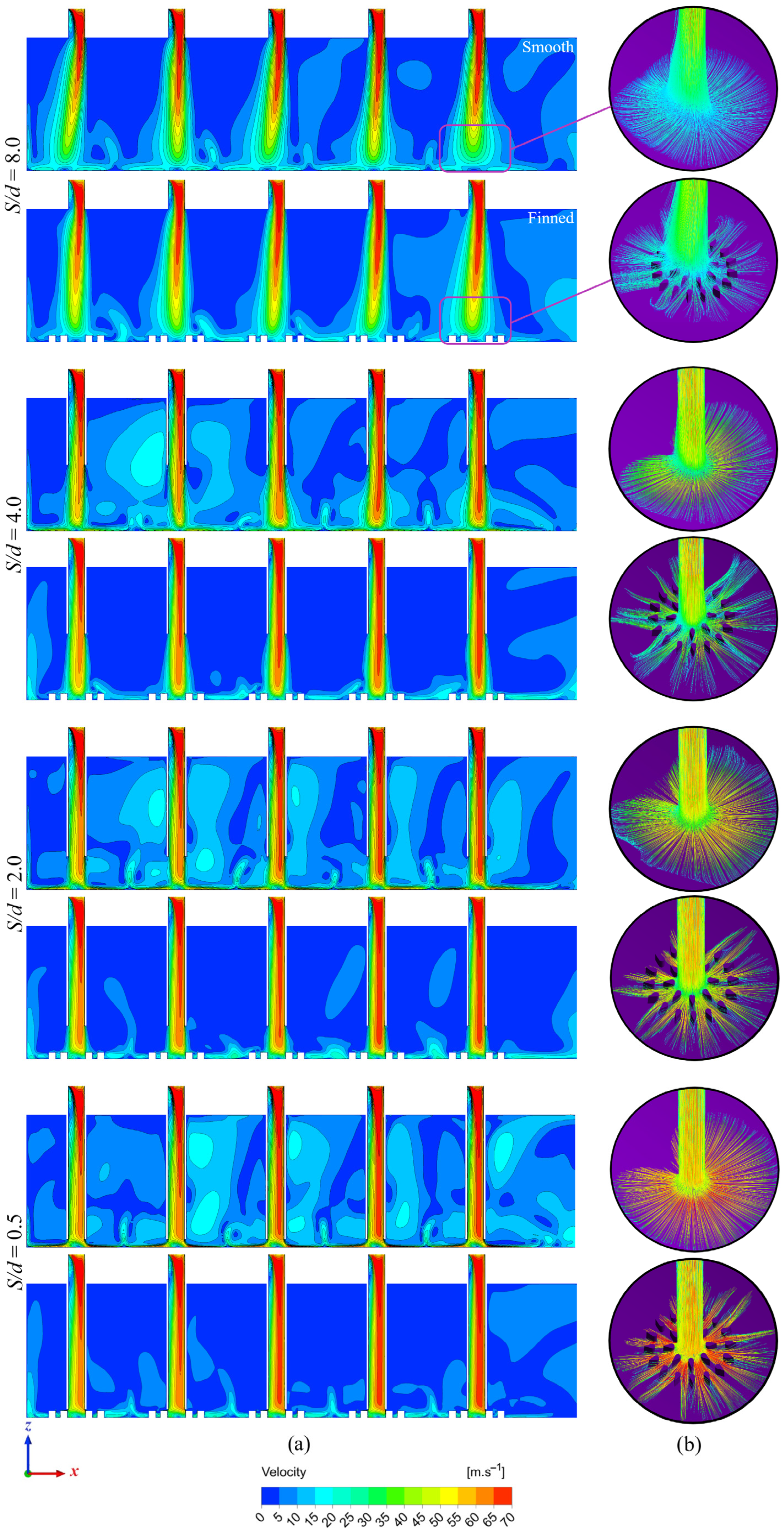
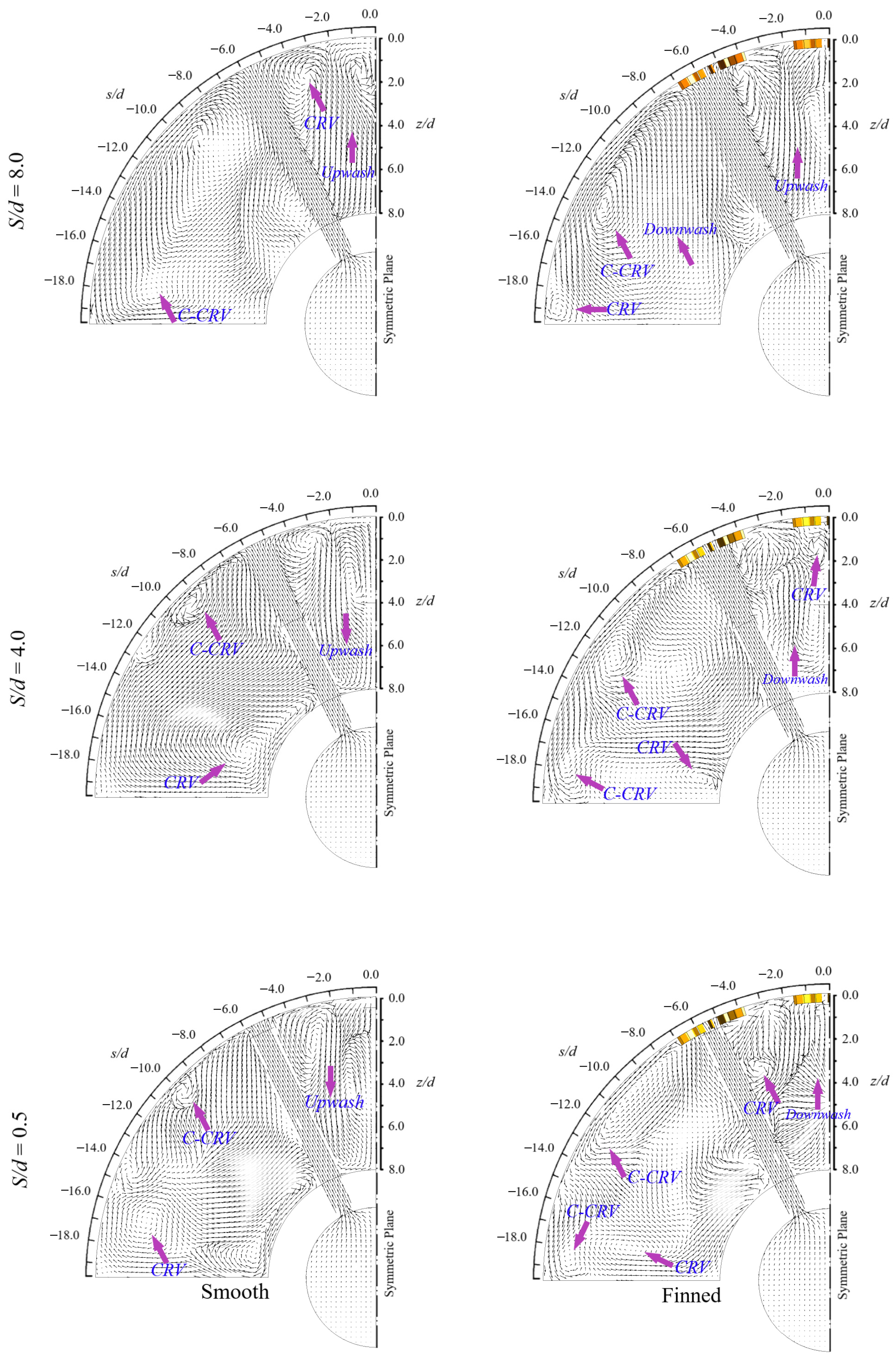
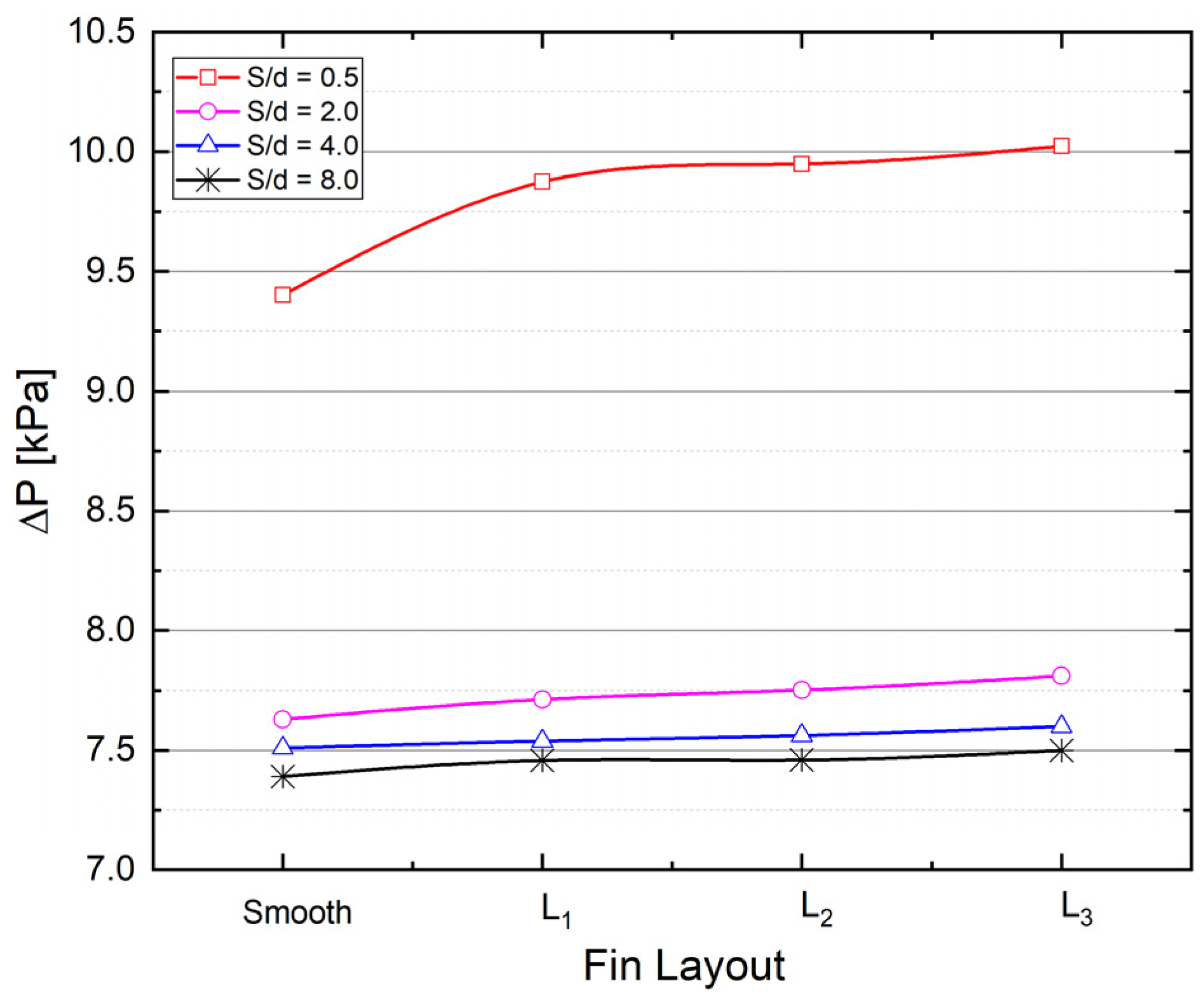
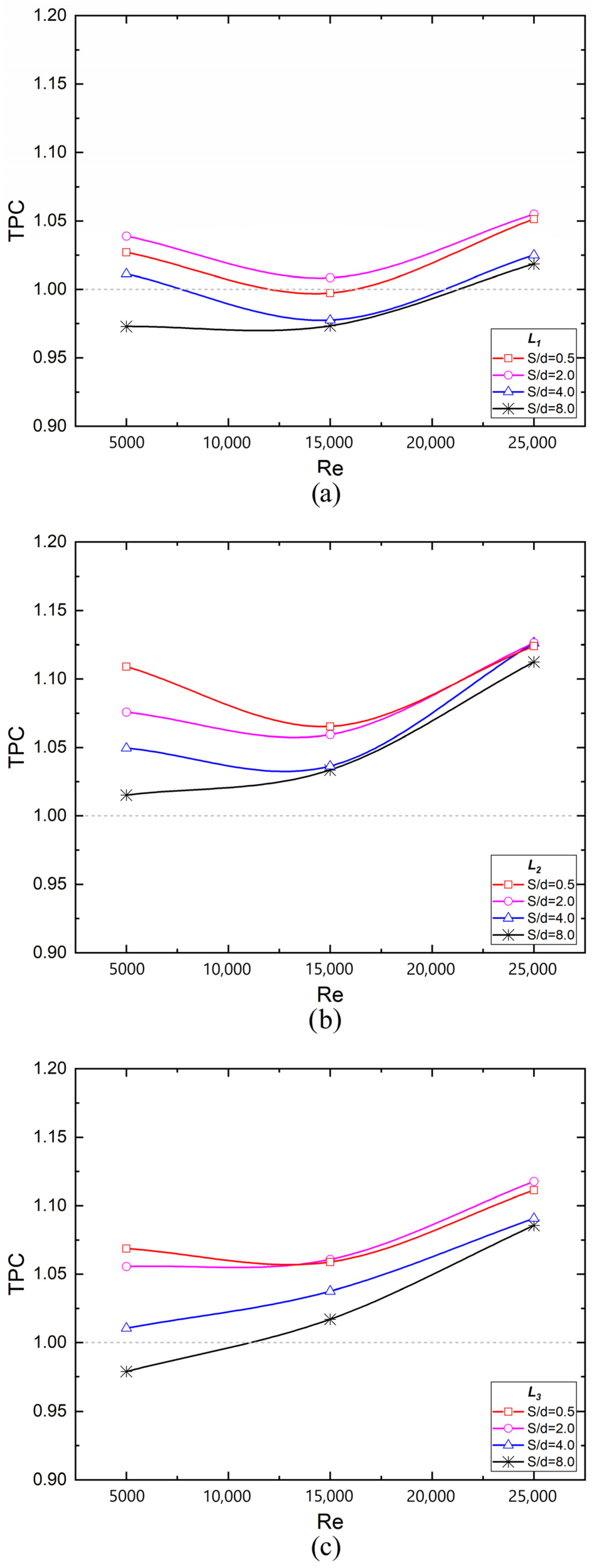
| Mesh Type | Type 1 | Type 2 | Type 3 | Type 4 |
|---|---|---|---|---|
| Number of elements | 3.06 × 106 | 5.55 × 106 | 7.95 × 106 | 8.83 × 106 |
| Nodes | 9.47 × 106 | 21.1 × 106 | 25.3 × 106 | 28.2 × 106 |
| Nu | 46.51 | 45.26 | 44.44 | 44.12 |
| y+ | 1.76 | 1.22 | 0.91 | 0.90 |
Disclaimer/Publisher’s Note: The statements, opinions and data contained in all publications are solely those of the individual author(s) and contributor(s) and not of MDPI and/or the editor(s). MDPI and/or the editor(s) disclaim responsibility for any injury to people or property resulting from any ideas, methods, instructions or products referred to in the content. |
© 2024 by the authors. Licensee MDPI, Basel, Switzerland. This article is an open access article distributed under the terms and conditions of the Creative Commons Attribution (CC BY) license (https://creativecommons.org/licenses/by/4.0/).
Share and Cite
Yalçınkaya, O.; Durmaz, U.; Tepe, A.Ü.; Benim, A.C.; Uysal, Ü. Heat and Flow Characteristics of Aerofoil-Shaped Fins on a Curved Target Surface in a Confined Channel for an Impinging Jet Array. Energies 2024, 17, 1238. https://doi.org/10.3390/en17051238
Yalçınkaya O, Durmaz U, Tepe AÜ, Benim AC, Uysal Ü. Heat and Flow Characteristics of Aerofoil-Shaped Fins on a Curved Target Surface in a Confined Channel for an Impinging Jet Array. Energies. 2024; 17(5):1238. https://doi.org/10.3390/en17051238
Chicago/Turabian StyleYalçınkaya, Orhan, Ufuk Durmaz, Ahmet Ümit Tepe, Ali Cemal Benim, and Ünal Uysal. 2024. "Heat and Flow Characteristics of Aerofoil-Shaped Fins on a Curved Target Surface in a Confined Channel for an Impinging Jet Array" Energies 17, no. 5: 1238. https://doi.org/10.3390/en17051238
APA StyleYalçınkaya, O., Durmaz, U., Tepe, A. Ü., Benim, A. C., & Uysal, Ü. (2024). Heat and Flow Characteristics of Aerofoil-Shaped Fins on a Curved Target Surface in a Confined Channel for an Impinging Jet Array. Energies, 17(5), 1238. https://doi.org/10.3390/en17051238







